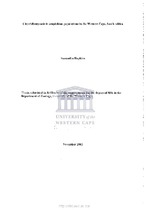| dc.contributor.advisor | Channing, Alan | |
| dc.contributor.author | Hopkins, Samantha | |
| dc.date.accessioned | 2015-10-19T15:03:20Z | |
| dc.date.available | 2015-10-19T15:03:20Z | |
| dc.date.issued | 2002 | |
| dc.identifier.uri | http://hdl.handle.net/11394/4590 | |
| dc.description | Magister Scientiae (Biodiversity and Conservation Biology) - MSc (Biodiv and Cons Biol) | en_US |
| dc.description.abstract | There have been many cases reported of amphibian populations declining. These are often due to anthropogenic factors such as habitat destruction and pollution. However, some declines have not had an obvious cause and many of these have been investigated and found to be due to pathogenic disease. Batrachochytrium
dendrobatidis is a recently described pathogen of frogs. The population declines that have been associated with chytridiomycosis have occurred in relatively undisturbed areas such as national parks. The declines tend to occur at higher altitudes or in colder climates. This is thought to be because of the frog immune system being slower at lower temperatures. Chyt1id fungus has been found in frog populations throughout the world. Little research has been carried out in Africa although, chytridiomycosis has already been seen in Kenya and South Africa.
In this project frogs were sampled from selected transects in the Western Cape and
three sites in the Northern Cape. The effect of altitude on the occurrence of infection was tested in the Western Cape. It was found that 18 frogs were infected in the Western Cape and the effect of altitude was not significant. Large numbers of dead and dying frogs were found in two of the Northern Cape sites and the incidence of chytridiomycosis was high in these populations. Chytrid was found in two Bufogariepensis from the Eastern Cape and in Xenopus petersii from Kasanka National Park, Zambia. More research is needed on chytridiomycosis in these populations. The frogs in the Western Cape seem to survive with chytrid fungus infection whereas, the frogs in the Northern Cape are dying. This suggests another factor acting on the Northern Cape frog populations. | en_US |
| dc.language.iso | en | en_US |
| dc.publisher | University of the Western Cape | en_US |
| dc.subject | Amphibian decline | en_US |
| dc.subject | Habitat destruction | en_US |
| dc.subject | Batrachochytrium dendrobatidis | en_US |
| dc.subject | Chytridiomycosis | en_US |
| dc.subject | South Africa | en_US |
| dc.subject | Zambia | en_US |
| dc.subject | Frogs | en_US |
| dc.subject | Western Cape | en_US |
| dc.title | Chytridiomycosis in amphibian populations in the Western Cape, South Africa | en_US |
| dc.type | Thesis | en_US |
| dc.rights.holder | University of the Western Cape | en_US |

